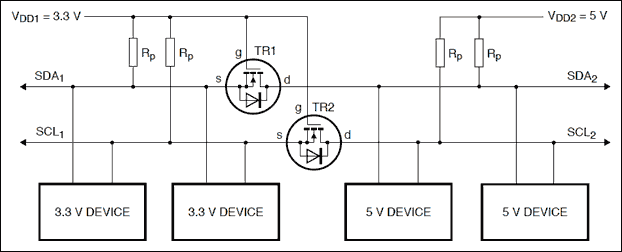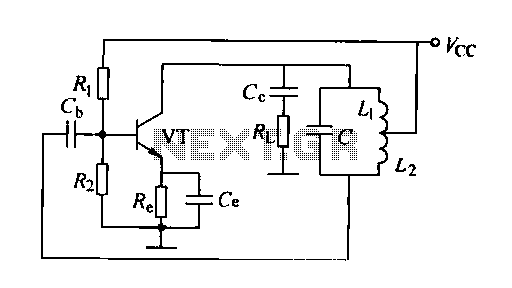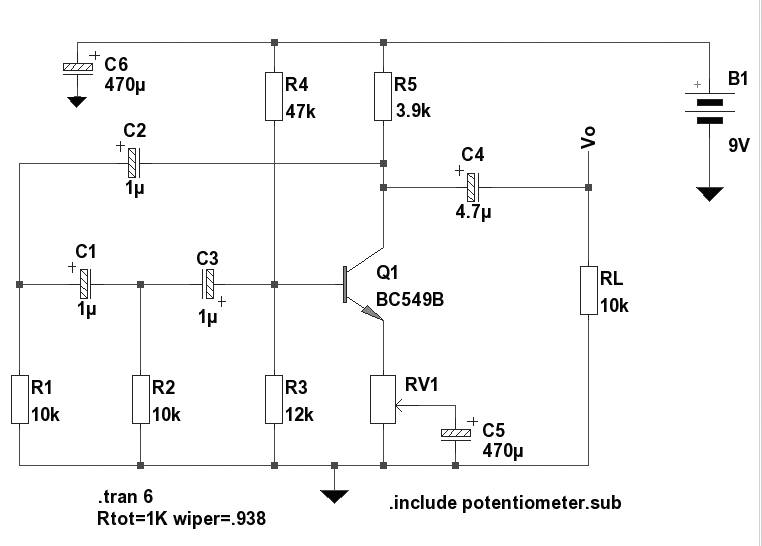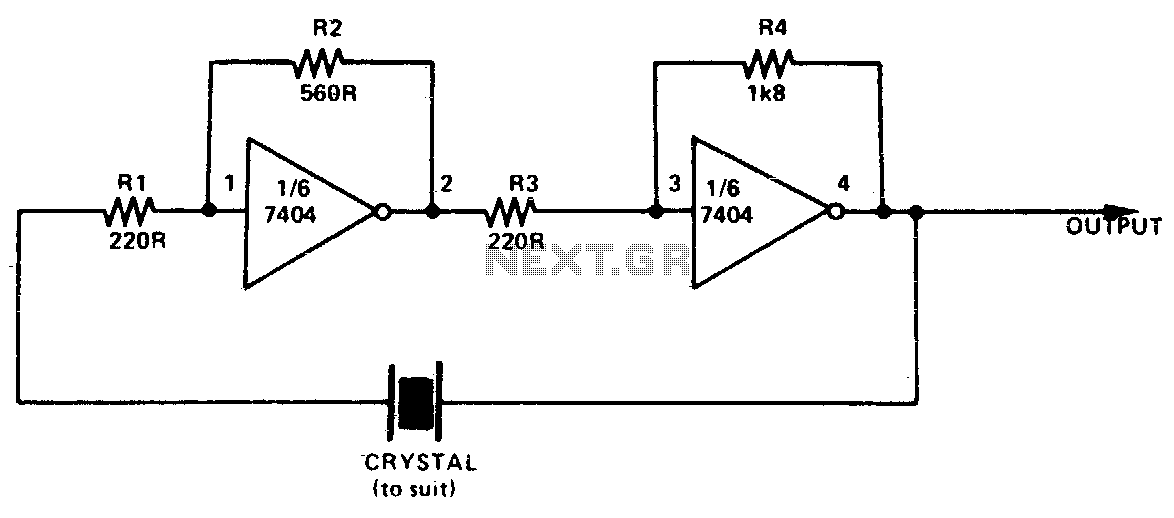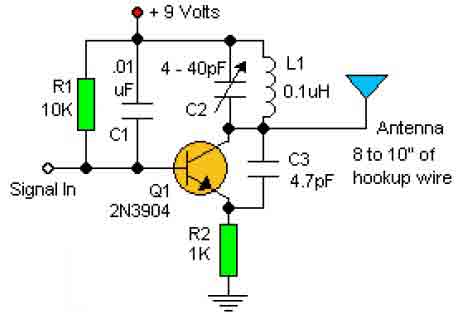
Phase shift oscillator
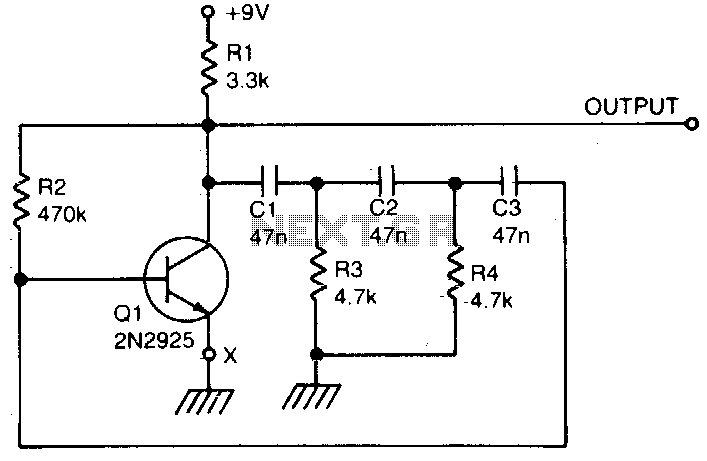
A single transistor is utilized to create a simple phase shift oscillator. The output produced is a sine wave with a distortion level of approximately 104. The purity of the sine wave can be improved by incorporating a variable resistor (25 ohms) in the emitter lead of Q1 (transistor). This resistor should be adjusted to the point where the circuit is just oscillating, resulting in a relatively pure sine wave. The operating frequency can be altered by adding a 10 kΩ variable resistor in series with resistor R3, or by modifying capacitors C1, C2, and C3. Setting C1, C2, and C3 to 100 nF will reduce the operating frequency by half. Additionally, the operating frequency can also be voltage-controlled using a FET in series with R3, or optically controlled using a light-dependent resistor (LDR) in series with R3.
The described circuit functions as a basic phase shift oscillator, which relies on a single transistor to generate oscillations. The transistor acts as an amplifier, while the phase shift network, composed of resistors and capacitors, determines the frequency of oscillation. The distortion level of 104 indicates that the output sine wave may not be perfectly sinusoidal, which is common in simple oscillator designs.
To enhance the output waveform quality, a variable resistor of 25 ohms is connected to the emitter of the transistor Q1. This resistor allows for fine-tuning of the oscillation threshold, ensuring that the circuit remains in a state of oscillation without excessive distortion. The adjustment of this resistor is critical, as it directly influences the feedback and stability of the oscillator circuit.
The operating frequency of the oscillator can be modified through several methods. By integrating a 10 kΩ variable resistor in series with R3, the resistance can be adjusted to change the time constant of the RC network, thereby altering the frequency. Furthermore, the capacitors C1, C2, and C3 play a significant role in determining the frequency; using capacitors with a value of 100 nF will effectively halve the frequency of oscillation.
For more advanced control of the frequency, a field-effect transistor (FET) can be integrated in series with R3, allowing for voltage-controlled frequency modulation. This method provides a means of dynamically adjusting the frequency based on the input voltage. Alternatively, an LDR can be employed for optical control of the frequency, where the resistance of the LDR changes in response to light levels, thus affecting the oscillation frequency based on ambient light conditions.
Overall, this phase shift oscillator circuit demonstrates flexibility in frequency control and output quality enhancement, making it a valuable design for various applications in signal generation and waveform shaping.A single transistor makes a simple phase shift oscillator. The output is a sine wave with distortion of about 104. The sine wave purity can be increased by putting a variable resistor (25 ohms) in the emitter lead of Q1 (x). The resistor is adjusted so the circuit is only just oscillating, then the sine wave is relatively pure.
Operating frequency may be varied by putting a 10 K variable resistor in series with R3, or by changing CI, C2, and C3 Making CI, 2,-3 equal to 100 nF will halve the operating frequency Operating frequency canalsobe voltage controlled by a FET in series with R3, or optically controlled by an LDR in series with R3. 🔗 External reference
The described circuit functions as a basic phase shift oscillator, which relies on a single transistor to generate oscillations. The transistor acts as an amplifier, while the phase shift network, composed of resistors and capacitors, determines the frequency of oscillation. The distortion level of 104 indicates that the output sine wave may not be perfectly sinusoidal, which is common in simple oscillator designs.
To enhance the output waveform quality, a variable resistor of 25 ohms is connected to the emitter of the transistor Q1. This resistor allows for fine-tuning of the oscillation threshold, ensuring that the circuit remains in a state of oscillation without excessive distortion. The adjustment of this resistor is critical, as it directly influences the feedback and stability of the oscillator circuit.
The operating frequency of the oscillator can be modified through several methods. By integrating a 10 kΩ variable resistor in series with R3, the resistance can be adjusted to change the time constant of the RC network, thereby altering the frequency. Furthermore, the capacitors C1, C2, and C3 play a significant role in determining the frequency; using capacitors with a value of 100 nF will effectively halve the frequency of oscillation.
For more advanced control of the frequency, a field-effect transistor (FET) can be integrated in series with R3, allowing for voltage-controlled frequency modulation. This method provides a means of dynamically adjusting the frequency based on the input voltage. Alternatively, an LDR can be employed for optical control of the frequency, where the resistance of the LDR changes in response to light levels, thus affecting the oscillation frequency based on ambient light conditions.
Overall, this phase shift oscillator circuit demonstrates flexibility in frequency control and output quality enhancement, making it a valuable design for various applications in signal generation and waveform shaping.A single transistor makes a simple phase shift oscillator. The output is a sine wave with distortion of about 104. The sine wave purity can be increased by putting a variable resistor (25 ohms) in the emitter lead of Q1 (x). The resistor is adjusted so the circuit is only just oscillating, then the sine wave is relatively pure.
Operating frequency may be varied by putting a 10 K variable resistor in series with R3, or by changing CI, C2, and C3 Making CI, 2,-3 equal to 100 nF will halve the operating frequency Operating frequency canalsobe voltage controlled by a FET in series with R3, or optically controlled by an LDR in series with R3. 🔗 External reference
